 A recent study out of University College London confirmed a very strong connection between social media use and depressive symptoms in teenagers. And this connection was much stronger in girls than in boys. (This does not mean that social media causes depression -- it just means that we know that children who use more social media have more depressive symptoms. More research needs to be done to figure out the reason behind this.)
A recent study out of University College London confirmed a very strong connection between social media use and depressive symptoms in teenagers. And this connection was much stronger in girls than in boys. (This does not mean that social media causes depression -- it just means that we know that children who use more social media have more depressive symptoms. More research needs to be done to figure out the reason behind this.)
The researchers looked at four explanations for why this might be. Poor sleep, online harassment, poor self-esteem, and poor body image all played a role.
My mind’s eye went immediately to my three wonderful, intelligent, strong and independent daughters, and to the social media apps that are such an integral part of their lives. My 15-year-old texts and video-chats with her friends through Snapchat, FaceTime and Whatsapp. My 13-year-old creates lip-syncing videos to share with her buddies via TikTok. And my 9-year-old immerses herself in a virtual zoological Animal Jam world of colorful biomes and customizable animals.
These apps provide positive experiences, such as socializing with friends, expressing emotions through creative cinematography, and learning facts about wildlife and its habitats. My little one often claims, “I’m so much better at typing now that I am using Animal Jam all the time!” Indeed, there is something to be said for the technical savvy that children are picking up as they navigate their way through social media landscapes that often baffle the older generation. If electronic communication is the way of the future, then it can be helpful to hone their digital skills at early ages.
In fact, there are a myriad of benefits to social media. The American Academy of Pediatrics lists a few: offering of opportunities for community engagement, such as political or charitable events; fostering of ideas through blogs, videos, podcasts and games; opening of doors to connect with people of diverse backgrounds in a much smaller and more interconnected global world; enhancing of learning opportunities as students gather together in group chats to work on homework or projects; and greater access to health information about topics that teens might otherwise not feel comfortable discussing with adults (such as mental or sexual health issues).
So there are pros and cons. This leaves us with so many questions. How do we parents find the balance? That sweet spot where they reap the benefits but are protected from the pitfalls? How much do we need to worry about impending depression or anxiety creeping up on them? How much time is too much time on social media? What can I do to mitigate these scary-sounding effects the devices might be having on my children?
I don’t have all the answers, but I do have some thoughts on how parents can help teens use social media thoughtfully and appropriately:
- Create screen-free zones, such as bedrooms and kitchen tables. And screen-free times such as mealtime and before bedtime. This will help reduce the amount of time kids are on their devices and allow for better quality and quantity sleep. (The devices might need to be given a “curfew” to enforce this tactic. A charging station in the kitchen or other central room can also be a good spot to park the devices for the night.)
- Open the lines of communication with your kids. Talk to them about their social media experiences. Educate them about the advantages and disadvantages. Have ongoing conversations about anything they want to talk about, and reassure them that you are the trusted adult they can turn to if/when they become mired in teenage angst.
- Keep in mind that it is not only quantity, but quality, that is important. Keep abreast of the apps your children are using, and encourage them to use social media in positive ways.
- Avoid banning, blocking or restricting your kids’ access to social media sites. This generally doesn’t work and may backfire if the forbidden fruit becomes so tempting that they simply use it behind your back.
- Be a good example to your kids. Use your own devices less! Engage with your children, and on your own, in non-screen activities. Enjoy the outdoors, read a book, play a game, do some fun activities as a family. Wax nostalgic for the days of yore when smartphones didn’t exist but people still knew how to enjoy!
My three girls are living in the wild west of cyberspace, with a frontier that is open to exploration. I hope that I can help guide them to that sweet spot of not-too-much and not-too-little, so that they enjoy the positive without enduring the negative along the way.
Elana Pearl Ben-Joseph, MD, is a visiting scholar with the Youth, Media & Wellbeing Research Lab at the Wellesley Centers for Women. She is also a pediatrician and medical editor at Nemours Children’s Health System's KidsHealth.org.


 Video games are on my mind these days. Especially violent ones, like Call of Duty or Grand Theft Auto. But special recognition goes to
Video games are on my mind these days. Especially violent ones, like Call of Duty or Grand Theft Auto. But special recognition goes to 